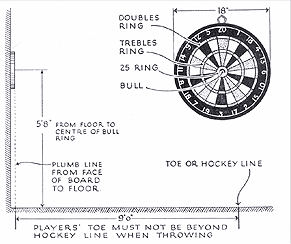

















 |














|

 | |||||||||||||||
|
| НАШ ОПРОС |
| Архив Опросов |

Правила Игры в Дартс
|
Reproduced from 1950 Unicorn Book of Darts Originally compiled by F. Lowy for In view of the widespread distribution of the game and the resulting impossibility of establishing an effective controlling body, it is not surprising that the rules of darts vary in different parts of the country. It would be impossible to record here all variations of the game as practised in different areas, these notes will, therefore, be confined to rules most generally adopted. In some parts of the country, boards known as Fives, Yorkshire or Irish and Manchester are preferred and the distance of throw varies from seven to nine feet. The clock board, as illustrated is, however, undoubtedly the most popular, and the most usual throw is nine feet, measured from a plumb line from the face of the board to the floor. The game may be played as singles or between teams of two to eight a side. Scoring is effected by setting an initial figure, from which the value of the throws is deducted, the player or side reaching nil first being the winner. For two players the starting figure is usually 301 or 501, referred to as "301 up" etc; for team play the game may be up to "1,001 up".
In the singles game, or in two to four a side games, it is usual to start with a double, meaning that no darts count until the player throws a dart in the doubles ring. For eight-a-side team play this rule is often waived, but all games must finish on a double, which means that the winning dart must be thrown in the doubles ring, the only exception to this being that a winning throw may be made by hitting the bull, for which purpose the bull counts as double 25. Each player throws three darts when his turn comes (hence three darts make a 'set'), the player's score is the total scored with the three darts, except that if a dart does not stick in the board or falls out after it has stuck in the board, only the dart or darts score which remain in the board when the player has finished his throw. A dart sticking in another dart does not score. If, at the end of the game, the player throws more than required for finishing, his throw does not count, the exact number required for finishing must be thrown either in the doubles ring or the bull ring. It follows from this that a player can only finish on an even number. The above, in conjunction with the illustration, are all the rules required for playing a good game of darts, but for League and Championship tournaments numerous additional rules or bye-laws are usually devised, controlling such matters as toss for start, the obligations of players, the validity of scores, the settlement of disputed and so forth. These additional rules or bye-laws do not, however, alter the fundamental rules of the game as outlined. |
Сайт управляется системой uCoz

| Дартс | Наследие | Яндекс
 | Скачать | Ссылки | Контакты | ЮниТесты | Выход
| Скачать | Ссылки | Контакты | ЮниТесты | Выход
Это интересно:


 Darts thrown into each division count the number indicated on the board, those falling in the doubles ring count double, those in the trebles ring treble, those in the 25 ring 25 and those in the bull ring 50.
Darts thrown into each division count the number indicated on the board, those falling in the doubles ring count double, those in the trebles ring treble, those in the 25 ring 25 and those in the bull ring 50.